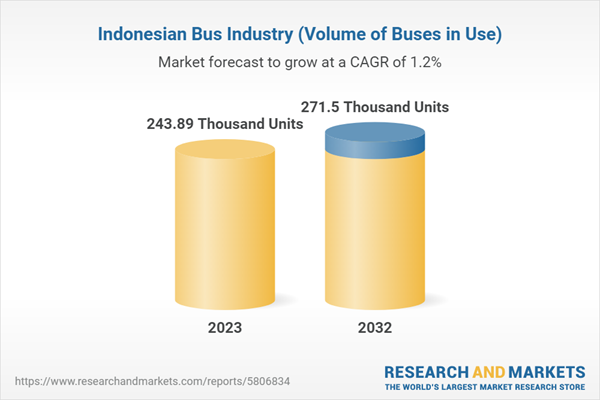Indonesia's well-developed tourism industry attracts many tourists to visit Indonesia every year. Bus travel is a popular and affordable way to visit Indonesia, and with bus connections to most major towns and cities, it is very convenient for tourists and the demand for road passenger transportation is growing. And with Indonesia's regional economic development, more investment in infrastructure construction, and gradual improvement in road conditions, the Indonesian bus industry has great potential for future growth.
In 2022, Indonesia received 4.6 million visitors, just 28% of the 16 million visitors it will receive in 2019. As the economy recovers and tourism is gradually recovering, the analyst expects Indonesia's visitor arrivals to grow rapidly in 2023.
From 2018 to 2022, According to the analysis, the number of buses in operation in Indonesia shows an overall rising trend with a CAGR of 2.00% from 2018 to 2022, which indicates that the net increase in buses in Indonesia has been positive every year for the last five years, and the number of buses in operation has been increasing year by year. at the end of 2022, the number of buses in operation in Indonesia is 241,000, an increase of 1.54% year-on-year.
According to the analyst, the number of buses in use will reach US$ 271.53 thousand in 2032 and the CAGR in 2023 to 2032 is 1.2%。
The Indonesian government is developing extensive infrastructure development plans, especially road transportation related infrastructure development. In recent years, public transportation in Jakarta and its surrounding areas has grown rapidly, doubling in the past two years. This is bound to have some impact on the ecological environment of the city, so the Indonesian government intends to focus on the electric transportation industry to reduce the environmental impact of heavy traffic commuting. The Ministry of Transportation expects to put in 41,000 electric buses, and the first phase is expected to put in 1,000 volumes of electric buses per year.
In addition, According to the analyst, by 2030, the Indonesian government is expected to invest a total of $450 billion in infrastructure projects, including toll roads, new intercity highways (Trans-Javanese, Trans-Sumatra, Trans-Sulawesi, Trans-Kalimantan, Trans-Papua), BRT systems, railroad projects (MRT, LRT, High and High Speed Rail), new airports, new ports, etc. This will contribute to the development of Indonesia's transportation sector, especially land transport.
Topics Covered
- Indonesia Bus Industry Overview
- The economic and policy environment of the bus industry in Indonesia
- What is the impact of COVID-19 on the Indonesian bus industry?
- Indonesia Bus Industry Market Size 2023-2032
- Analysis of major Indonesian bus industry producers
- Key Drivers and Market Opportunities in Indonesia Bus Industry
- What are the key drivers, challenges and opportunities for the Indonesian bus industry during the forecast period 2023-2032?
- Which are the key players in Indonesia Bus Industry market and what are their competitive advantages?
- What is the expected revenue of Indonesia Bus Industry market during the forecast period 2023-2032?
- What are the strategies adopted by the key players in the market to increase their market share in the industry?
- Which segment of the Indonesia Bus Industry market is expected to dominate the market in 2032?
- What are the main negative factors facing the bus industry in Indonesia?
Companies Mentioned
- Bianglala
- Koantas Bima
- Kopaja Kopkarmi
- Mayasari Bhakti
- BMW AG
Methodology
Background research defines the range of products and industries, which proposes the key points of the research. Proper classification will help clients understand the industry and products in the report.
Secondhand material research is a necessary way to push the project into fast progress. The analyst always chooses the data source carefully. Most secondhand data they quote is sourced from an authority in a specific industry or public data source from governments, industrial associations, etc. For some new or niche fields, they also "double-check" data sources and logics before they show them to clients.
Primary research is the key to solve questions, which largely influence the research outputs. The analyst may use methods like mathematics, logical reasoning, scenario thinking, to confirm key data and make the data credible.
The data model is an important analysis method. Calculating through data models with different factors weights can guarantee the outputs objective.
The analyst optimizes the following methods and steps in executing research projects and also forms many special information gathering and processing methods.
1. Analyze the life cycle of the industry to understand the development phase and space.
2. Grasp the key indexes evaluating the market to position clients in the market and formulate development plans
3. Economic, political, social and cultural factors
4. Competitors like a mirror that reflects the overall market and also market differences.
5. Inside and outside the industry, upstream and downstream of the industry chain, show inner competitions
6. Proper estimation of the future is good guidance for strategic planning.

LOADING...
Table Information
| Report Attribute | Details |
|---|---|
| No. of Pages | 60 |
| Published | May 2023 |
| Forecast Period | 2023 - 2032 |
| Estimated Market Value in 2023 | 243.89 Thousand Units |
| Forecasted Market Value by 2032 | 271.5 Thousand Units |
| Compound Annual Growth Rate | 1.2% |
| Regions Covered | Indonesia |
| No. of Companies Mentioned | 5 |









